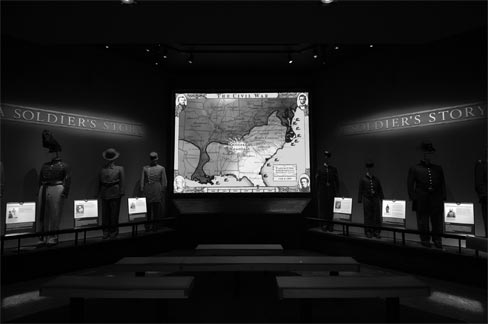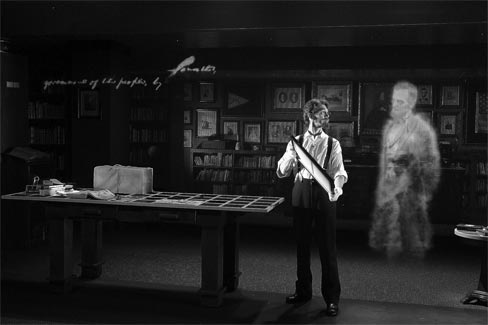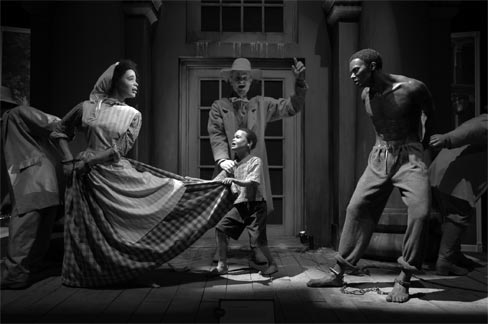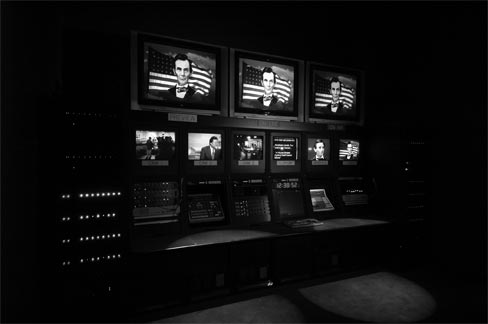Exhibit Review
Abraham Lincoln Presidential Library and Museum
Springfield, Illinois; Designers: Illinois Historic Preservation Agency and BRC Imagination Arts
Permanent
In Abraham Lincoln's hometown of Springfield, Illinois, places associated with the 16th U.S. president have been receiving a great deal of attention over the past few years in anticipation of the bicentennial of his birth in 2009. The State of Illinois completed one of the largest Lincoln-related projects, the more than $115 million Abraham Lincoln Presidential Library and Museum complex, in 2005. Operated by the Illinois Historic Preservation Agency, the facility describes itself as providing "scholarship with showmanship."
The concept of a presidential library and museum dedicated to Abraham Lincoln was not new. The National Park Service had conducted a feasibility study for an "Abraham Lincoln Research and Interpretive Center" in the early 1990s. Although the idea did not proceed beyond those early studies, the National Park Service shared the information gained during that process with the Illinois Historic Preservation Agency.
The library and museum project received funding from a variety of sources, including $50 million from the Federal Government. Construction took place in phases. The Abraham Lincoln Presidential Library opened in October 2004. The Illinois Historic Preservation Agency transferred the holdings of the 118-year-old Illinois State Historical Library to the new facility. While some people are disappointed that the long and varied history of the State of Illinois, from French Colonial settlement, to Chicago's 1893 World's Columbian Exposition, to the 1968 Democratic National Convention and beyond, is now housed behind the name of Abraham Lincoln, few can complain about the quality of the new facility.
The 3-story, 98,000 square foot library contains 33,000 square feet of storage space for the institution's 12 million items, including books, maps, broadsides, photographs, and other documents. The library's famed 47,000-item Henry Horner Lincoln Collection, named for the 1930s Illinois governor who donated his impressive Lincoln collection to the state, is one of the reasons why the State of Illinois took on the construction project in the first place. The Horner collection has been called "the most complete holding of Abraham Lincoln's pre-presidential materials" and contains letters, manuscripts, artifacts, photographs, prints, and broadsides that have drawn Lincoln scholars from around the world to Springfield for generations. The library also includes an attractive and comfortable reading room, classrooms, conservation labs, and a large multi-purpose room for broadcasting or hosting distance learning sessions.
The new Abraham Lincoln Presidential Museum is next door to the library. There, the goal was to create a new type of museum that would be, as the promotional video states, different from "ordinary museums that take wonderful objects of the living past and imprison them in row upon row of glass boxes." Its 46,000 square feet of permanent exhibit space features immersion exhibits such as Lincoln's Indiana cabin, the White House Cabinet Room, the White House kitchen, Ford's Theatre, and the Old [Illinois] State Capitol's Representatives Hall, where museum visitors file past Lincoln's casket as mourners did in May 1865. Not all of the immersion exhibits are to scale, which raises some questions about appropriateness and accuracy. The facility also includes a 250-seat multi-stage and screen presentation titled Lincoln's Eyes, a holographic theater called Ghosts of the Library, a Treasures Gallery displaying the Gettysburg Address and other artifacts, and a children's area called Mrs. Lincoln's Attic that features a large model of the Lincoln Home. Throughout the museum, a visitor comes in contact with a series of "Lincolns," full-scale life-like representations of Lincoln as a boy in Indiana or as president sitting at Ford's Theatre on that fateful April night. Visitors also encounter Frederick Douglass, Sojourner Truth, George McClellen, Ulysses Grant, members of Lincoln's Cabinet, John Wilkes Booth, and other historic figures.
The Lincoln Museum claims to have set a new standard for museum exhibits in terms of entertainment value. The Illinois Historic Preservation Agency paired an exhibit design team from BRC Imagination Arts of Burbank, California, with a team of Lincoln scholars to present the story of Lincoln from his boyhood in Indiana to his assassination in Washington, DC. Yet, the scholarship—such as the text describing the complex slave crisis, which is presented in traditional labels and artifact displays—can be easily overshadowed by the installations themselves. For example, a life-size installation of a slave auction, which includes a father being torn away from his wife as their confused young child looks on, and a Tim Russert "Meet the Press"-style analysis of the four-way 1860 presidential race, definitely divert attention away from the labels explaining the scenes to visitors. In the Russert studio exhibit, television commercials explaining the four candidates' positions as if their campaigns were taking place today predominate.
Another dramatic exhibit is a large animated map of the United States titled "The Civil War in Four Minutes," which depicts major battles and the constantly moving battle lines as the war progresses. The map includes a counter that constantly tracks war casualties, one tally for northern and another for southern. A subtle point is that the numbers continue to increase even when there are no battles, due to death by disease that claimed more lives than did combat.
Other scenes from Lincoln's presidential years portray Lincoln and his wife, Mary Todd, at the deathbed of their son, Willie, who died in 1862 at the age of 12. Lincoln's internal struggle over whether to issue the Emancipation Proclamation is represented in a series of audiovisual vignettes of people arguing both sides in mean and unpleasant language. Lincoln stands alone, to decide for himself.
 |
"The Civil War in Four Minutes" exhibit depicts major battles and the constantly moving battle lines of the Civil War. (Courtesy of the Abraham Lincoln Presidential Library and Museum.) |
 |
The Abraham Lincoln Presidential Library and Museum includes a holographic theater called Ghosts of the Library. (Courtesy of the Abraham Lincoln Presidential Library and Museum.) |
The two elements of the museum that have generated the most interest are the theater programs. In Ghosts of the Library, an actor playing an historian enters a stage that appears to be a library reading room and talks about the importance of "all this old stuff." He answers the question of "who cares" by telling heart-wrenching stories of the Lincoln family and the Civil War amid holographic images or "ghosts" of Lincoln, Mary Todd, Civil War battle scenes, and other scenes. As the program closes, the actor reveals that he is a ghost of a Civil War soldier killed in battle as the library turns into a battlefield through holographic projections on the glass wall that separates the audience from the stage.
The second theater program is Lincoln's Eyes, narrated by an artist commissioned to paint a Lincoln portrait for the museum. The artist tells Lincoln's story as he explains how he tried to understand the various emotions he saw in existing images of Lincoln. The film is a multi-media presentation with moving screens, shaking seats, cannon firings, and John Wilkes Booth walking above the audience along a catwalk on his way to assassinate Lincoln, all provided through special effects, including real smoke rings floating into the auditorium.
The staff at Lincoln Home National Historic Site was unsure what to expect once the museum opened. Would visitors feel that seeing the new museum was enough and that they could continue their trip to Chicago or St. Louis? To its credit, the museum encourages visitors to go see the "real thing" at Lincoln Home after their visit, and, for the most part, visitors are heeding that advice. In anticipation of the museum opening, Lincoln Home staff spruced up the park's interpretive programming. The park installed new exhibits, regularly evaluates its interpretive programs, and is producing a new interpretive film. In the end, the main beneficiary of this good spirited "competition" among historic sites and museums is the visiting public.
Although some visitors wax nostalgic for the "traditional" museum, many love the new format, and they are coming to see the real thing. If, after a visit to the museum and other Springfield historic sites, visitors develop an interest in history or decide to pick up a book about Lincoln or the Civil War, then, together, the Abraham Lincoln Presidential Library and Museum, Lincoln Home National Historic Site, and the other historic sites in Springfield will have made a difference.
Timothy P. Townsend
Lincoln Home National Historic Site


